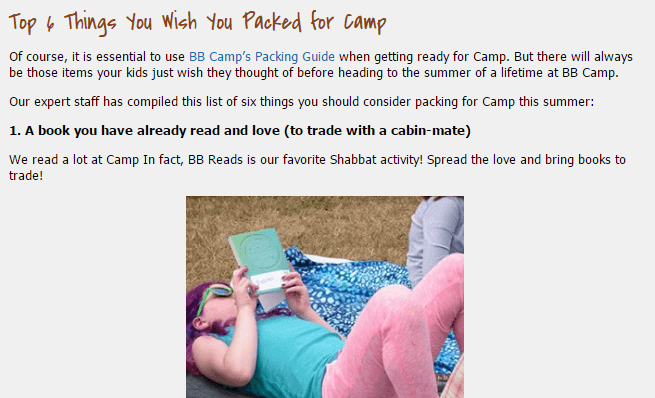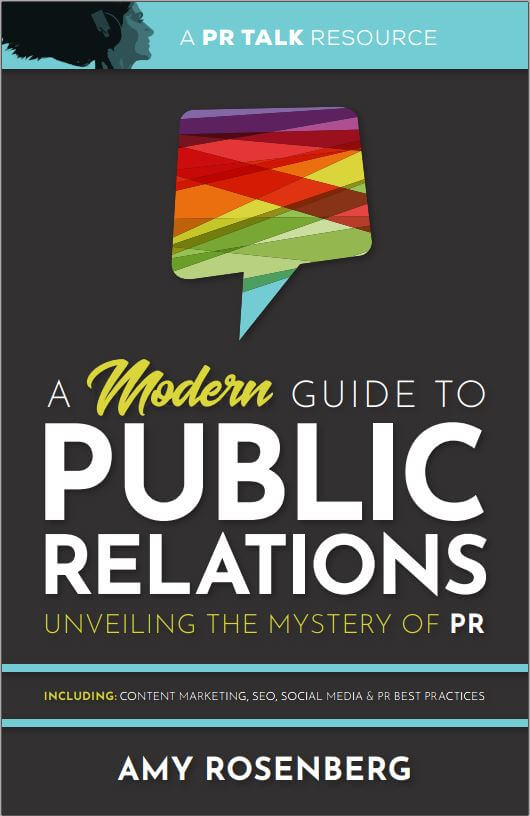Every organization has different resources, stakeholders and marketing needs. Follow this systematic guide for building a blogging plan with staff, a board and volunteers.
In this example, we are using a nonfictional nonprofit, BB Camp, that I happen to serve on the board and lead the marketing committee for. The rules and principles will work for any organization; adjust for your specific organizational chart.
There are five main questions to answer when creating a blogging schedule for your organization:
- What are you going to write about?
- Who are you writing to?
- Who is doing the blogging?
- How frequently are you going to post?
- What is your system for being efficient?
What are you going to write about?
Start broad, then get into the specific categories, topics and plan each of the posts. Map it out like this:
Categories – in general, what are you going to post about? These posts could promote product lines or programs.
BB Camp’s categories include the various programs we manage (summer camp, retreat rentals, kids activities, free book programs, after-school youth activities), goals of the organization (developing youth leadership, enhancing Jewish life, fundraising) and the geographies the organization operates in (Portland and the Oregon Coast).
Core Topics – what are the various topics that should be explored? Each category will have several core topics.
Taking the summer camp category in our BB Camp example, core topics include things like:
- Getting ready for camp
- Camp activities
- First-time campers
- Long-time campers
- Day camp
- Overnight camp
Post Topics – time to brainstorm all the potential post topics your organization can write about.
Now we get into specific topic ideas, so post topics such as What to Pack for Camp, What to Expect Your First Time at Camp, Campers Favorite Foods, Top Camp Aquatic Activities, and The Ultimate Sleepaway Camp Packing List are a few examples of post topics.
*Don’t forget to plan the type of post it will be (short form, long form, lists, infographics, etc.)
Who are you writing to?
Who are your audiences? Do you have personas already created? I got into this a bit more in my 7 Elements of a Blog Post piece.
At BB Camp we have at least four specific audiences including campers, parents, donors and potential renters. Each audience is unique in who they are and what type of content they are looking for. How to balance whom to write for and when to publish is an important part of your plan. The personnel working closest with each audience can give you a better idea of what they will want to consume. Which leads us to…
Who is doing the blogging?
Is it just you? What about other internal members of the organization? External authors, board members, volunteers, guest authors? What about editing and drafting the posts on your blog? Is this the responsibility of the author or do you need to put another system in place?
BB Camp:
Here is how I break it down for our sample organization:
Staff, board members, committee members and community volunteers contribute to the blog. They have access to a shared document that features the brainstormed blog topics. They also have access to a document that lists the various requirements (suggested and mandatory) for each post. This includes the suggested number of words for each post (a range from 500 – 1,500 is ideal), image(s) and link requirements and how to submit a completed post. All posts are delivered to the Marketing Manager and she is responsible for final review and posting.
How frequently are you going to post?
There’s no point in starting a blog if you aren’t going to consistently post. The frequency really depends on the plan and size of your organization. You can start slow to get the hang of it and ramp up from there. I think a great place to start is to expect each author to be able to write one post per X. The X depends on their role and how much time you can expect them to give you. Here are a few ideas for different types of authors:
Marketing & Sales Employees:
Once per month. Of course, some people don’t have writing skills, etc. but they have ideas and can contribute.
Volunteers:
In many volunteer situations, you take what you can get, but I think if someone is willing to write one blog post for you, asking them to contribute quarterly isn’t a stretch, so if you do get someone to raise their hand, plan for a post every three months from an average volunteer.
Board Members:
Similar to volunteers, you typically take what you can get from board members, as they are often also volunteers. However, they have a passion for what you are doing, so coming up with one post a year shouldn’t be too much of a stretch. If you have 12 board members willing to contribute once per year, that’s a post every month!
BB Camp:
Here is how I break it down for our sample organization:
| Department/Person | People in Dept | Frequency per Person | Posts per month |
| Marketing | 1 | Monthly | 1 |
| Rentals | 1 | Every other month | 0.5 |
| Development | 2 | 3x per year | 0.5 |
| Programing | 7 | 2x per year | 1 |
| Executive Director | 1 | Quarterly | 0.25 |
| Other Staff | 8 | Yearly | 0.5 |
| Board | 19 | Once every 3 years | 0.5 |
| Marketing Committee | 10 | Yearly | 0.5 |
| Community Volunteers | 100+ | Yearly | 1 |
| Total Posts Per Month | 5.75 |
Our goal is to start with a post each week and based on our breakdown, we end up with more than 5 posts each month, right on target.
Marketing & Sales Employees – 2 posts per month. BB Camp has four staff people that are expected to write two posts (combined) every month.
Other Staff – 1.75 posts per month. Seven staff members develop and execute programming for BB Camp. As a group, they are expected to contribute one post per month (one post every six months per person). The Executive Director is also responsible for a post a quarter and the other eight staff members a post every other month combined.
Volunteers – 2 posts per month. We ask our 19 Board Members to generate a post every other month (six of the board members write one post each during the year), our Marketing Committee members to contribute six posts per year and Community Volunteers (other committee members and volunteers at-large) to submit one post each month.
What is your system for being efficient?
The last thing you want to do is recreate your process every time a post is penned. This is your chance to create a documented, repeatable process. The easiest way to create the process is to simply document all the steps you go through to create and promote your initial posts. You will inevitably forget a few things the first time you write it down, so know it is a living document.
At a minimum, your process should include guidelines for the following:
Post Title – what is the desired word or character count? We aim for one full line across for each post (two lines max) which is typically about 35-50 characters (7-10 words).
Subtitle/sub-headline – is a subhead required? Do you use the H2 tag for it?
Image requirements – you should require at least one image per post. What are the size and layout requirements?
Featured image – does your blog specify a featured image?
Dimensions – what is the ideal (and consistent) size for your images? Do you have an archive to choose images from or other sources (free or paid) for images that you can use (don’t forget about image rights requirements)?
Compression – the smaller the file size the better. Check out TinyJPG for simple compression of jpg and png files.
Links – good blog posts have links to other relevant content (e.g. our Key Elements to a Blog Post), also try and link to something on your own site (as a referenced supporting article) to guide readers to your other content and potentially create an external link if your post is shared on other sites. We have a policy that external links open in a new tab.
Social share schedule & requirements – each blog post should be shared via appropriate social channels upon publication. The author can be required to submit blog posts with several sample posts for social sharing.










